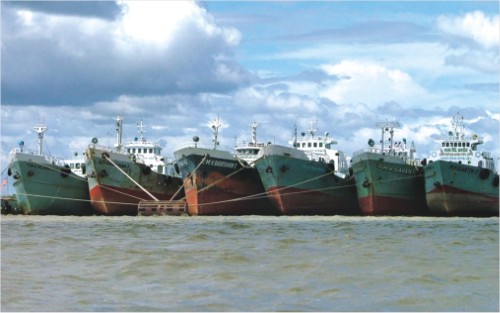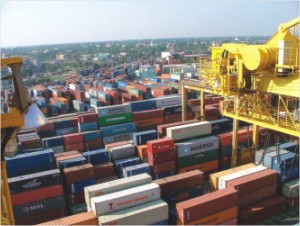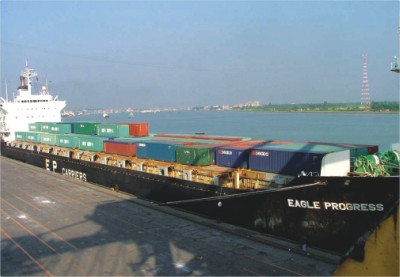
Inside
|
Our window on the world Rafiq Hasan dissects the current malaise in the shipping sector and suggests that a deep sea port serving the entire region is the way forward Ports are the lifeline of a country. Most of the foreign trade of a country depends on its sea ports. There are many countries in the world which do not have any sea port. As a result, those land-locked countries face a lot of difficulties in conducting export-import business. We are fortunate that we are not a land-locked country. We have a vast seashore, a number of sea ports, and dozens of river ports. But it is very unfortunate that we could not use the seashore and ports properly. Exports from Bangladesh have been increasing at a rate of over 25 percent for the last couple of years, while the import volume grew at a pace of around 20 percent. But the country's sea ports, the main channel for foreign trade, have not seen any major changes for facilitating the rising volume of export-import cargo in the last one decade. As a result, the Chittagong sea port which handles more than 80 per cent of export-import cargo is over-burdened, and has become a constant headache for the nation, taking heavy toll on the country's overall economy. Although the export-import trade witnessed significant development in the last one decade, no new major port has been set up in the country for handling the additional cargo. A small sea port was, however, set up in Teknaf during the immediate past BNP regime, mainly for handling export-import cargo with neighbouring Myanmar. An American company had come up with a proposal for setting up a new port at the estuary of the Karnaphuli river, besides the existing Chittagong port, during the previous Awami League period. The company, Stevedoring Services of America (SSA), had proposed to invest over $250 million in the first phase. The actual investment would have gone up to $1 billion had the port come into being. But the initiative for a private port was resisted by the locals led by Mayor ABM Mohiuddin Chowdhury. Although the high-ups of the then Awami League regime initially had agreed to the proposal, it was rejected later following massive agitation by Chowdhury's followers. Even though Chowdhury is a prominent Awami League leader, he did not support the AL government in this case. He argued that a new port at the very estuary of the shrinking river Karnaphuli would gradually diminish the importance of the existing Chittagong port. It a sense, Mohiuddin was right: a new port at the point proposed by SSA, would have ultimately killed the Chittagong port. However, at the same time, the country has been deprived of having a new modern port for smooth handling of increasing volume of foreign trade.
As the mega proposal for a private port was rejected, no foreign investors have since come up with any such proposal. Nor did the government apparently feel the necessity of setting up a new port in spite of the rapid growth in export-import volume in the country. Chittagong and Mongla are the two major sea ports in Bangladesh. Chittagong is the premier sea port as it handles more than 80 percent of the export-import cargo of the country. On the other hand, Mongla is now a dying port as it often suffers from dearth of ships. Sometimes Mongla remains completely vacant for weeks together due to non-arrival of ships. Besides, heavy siltation on the long channel made the port difficult for ships to enter. As a result, most of the big vessels show reluctance in coming upto the port terminal. Ships have to lighten half-way up the channel before anchoring at the terminal. Ships carrying bulk food items like wheat, rice, maize, fertilizer, and cement clinker mainly come to the second sea port, Mongla. Those, carry export items, mainly frozen foods, as return cargo. As the Chittagong port handles most of the incoming and outgoing cargo it always remains vibrant. It is now over-burdened with ships and containers. New development in shipping sector Most of the bulk ships have been replaced by container ships, and around 40 percent of world cargo is now carried in containers. The container mother vessels, carrying 10,000-20,000 containers, do not come to Bangladesh ports. They anchor at the sea ports in Singapore, Malaysia, or Sri Lanka. The Bangladesh-bound container cargo is at first unloaded at those ports and later carried up to Chittagong and Mongla by feeder vessels. Similarly, the export cargo in containers from Bangladesh follows the same route. Foreign dominance Under the banner of Chittagong Feeder Trade Committee (CFTC), they often hold the Chittagong port hostage and try to realize their demands. They also unilaterally increase the freight charges on various pretext. There are also a few Bangladeshi ship-owners in the syndicate, but they are cornered by the foreigners. HRC is the major Bangladeshi group, and operates 10 container ships on the route. The system of carrying bulk cargo has, however, remained unchanged. The government-owned Bangladesh Shipping Corporation (BSC) still operates eight bulk carrier ships. The Chittagong port actually handles cargo almost double its capacity. As a result, it always remains congested. The congestion of containers sometimes goes out of control. The outer anchorage of the port often has a long queue of waiting ships. Bad image abroad Criticizing the performance of the ports in Bangladesh, the World Bank, in its report on strategic issues in ports, said that the port sector had not changed much over the past decade: "All three major ports [Chittagong, Mongla, and river port of Dhaka-Narayanganj] suffer from overstaffing, labour strikes, cumbersome customs procedures, outdated and inefficient work rules and outdated and inflexible management practices." Although Chittagong sea port is heavily congested and overburdened, and Mongla is diminishing, there is hardly any initiative from the government side to set up a new sea port. The government's plan to set up a deep-sea sea port is unlikely to become reality in the near future. Problems First of all, it is a tidal port. The ships have to cross a nine nautical mile long channel for anchoring at the terminal. The ships can move on the channel only during high tide. Chittagong port now has three terminals. General yard for anchoring bulk carrier ships, container terminal for anchoring container ships, and a newly built new-mooring container terminal (NCT). The port has the facilities for anchoring 10-12 ships at those three terminals at a time. The Chittagong Container Terminal (CCT) has the most sophisticated equipment, quay gantry cranes (QGC), for handling containers. The four QGCs were installed last year, at a cost of Tk 150 crore. The container handling at the CCT has been accelerated after installing sophisticated cranes. The ship-to- shore crane is used for unloading containers directly from a ship and keeping it in a certain place on the shore. This sophisticated crane has been imported from Japan. Japanese technicians installed it at the terminal and gave training to the local operators for running the cranes. The premier Chittagong port is still plagued by lack of adequate equipment, inefficient operators and The actual loss to the nation for the delay had been 200 times higher than the amount, as the delay at the port shattered the total economy of the country, the CCI leaders said. Turn-around time The Chittagong port also does not follow the cut-off time for loading and unloading cargo. The port starts taking booking after a ship anchors at the terminal, and it continues for 24 hours. The shipping agents can increase the cut-off time with the permission of the port authority. But the ports in Singapore and Malaysia cease booking of export cargo at least 12 hours before anchoring the ship at the terminal. Those ports do not take booking of the return cargo after anchoring the ship at the terminal. Therefore, the ships do not stay at the terminal more than the 12 hours required for loading and unloading cargo. Cumbersome official and customs procedures are another problem in Chittagong port. The staffing and un-staffing of containers also take place at the yard, which is one of the major causes for congestion of the containers at the port yard. Apart from strikes and internal labour unrest, national politics also overshadow the port activities. The hartal and blockade programs hamper the loading and unloading activities. The activities of the port remained closed for several weeks during the recent political agitation. Before that, a serious row over operation of the QGC by a private company heavily disturbed the port activities. Development and expansion of Chittagong port The jetty can handle three container ships at a time. The new-mooring container terminal (NCT) set up recently, at a cost of Tk 700 crore, is yet to be commissioned fully. Although five container ships are supposed to anchor at the terminal at a time, only two ships can anchor there at present. The construction of the terminal was targeted to be completed by October 2006 but many parts of the terminal are still incomplete. The Chinese construction company has left Bangladesh without completing the construction work.
There is one public sector inland container depot (ICD) that is located in Kamlapur, Dhaka. The main purpose of the depot is to ease container congestion at the port jetty. The container is brought to Kamlapur in Dhaka directly by train immediately after being unloaded from the ship. The goods are released from the depot. The export cargo is also stored at the depot. The government also allowed private entrepreneurs to set up inland container depots. A total of 10 private depots have been established in private sector located at different places near Chittagong port. The container handling at the lone public sector ICD at Kamlapur, however, is facing various problems due to inefficiency of the private handling company. The government had appointed Global Agro Trade Company (GATCO) for handling the container at the depot. The company showed inefficiency in handling the containers, as the handling equipment it installed there often break down. The laden containers often remain piled up at the depot because of poor handling. The government is now considering cancellation of the agreement and appointment of a new company for smooth handling of goods.Dream of a deep sea port
The local political leaders of Chittagong and Cox's Bazar have been demanding that the deep sea port be set up in Moheskhali-Kutubdia. On the other hand, the leaders of Khulna and Bagerhat region want the port at Akram point, 60 kilometres down from the Mongla port on the river Pashur. The government last year appointed a foreign firm to conduct a feasibility study for setting up a deep-sea port in Bangladesh. The study is suppose to continue for one year, and after that a concrete recommendations would be submitted to the government suggesting the suitable place for the port. But nobody knows when the concept of deep sea port would finally come into being. The first Nobel laureate of the country Dr. Muhammad Yunus has also demanded setting up of a mega-port in Chittagong for exploring the potential of the area and bringing economic development. The development of Dhaka-Chittagong economic corridor mainly depends on a vibrant port, particularly a deep-sea port located somewhere in the eastern part of the country. The lands located on both sides of Dhaka -Chittagong highway are supposed to be used as the base land for the corridor. A gigantic port is necessary for quick disposal of export-import items of the corridor. Besides, neighbouring India, Nepal, Bhutan and China could be used as hinterland for the port.
Without opening doors for land-locked neighbours like Nepal, Bhutan, the north-eastern provinces of India and the western part of China, a deep sea port is unlikely to be viable in Bangladesh. No foreign investor would come up to invest in a multi-billion dollar project aimed only at Bangladesh-bound cargo. But they might be very much interested if a regional trade atmosphere is created through political decisions of the states. The requirement of money for such a massive infrastructure may be fulfilled from donor agencies or foreign investment, but a political decision first of all is pre-requisite for changing the mind-set and rethinking tight rules. Many countries in the world like Singapore earn billions of dollars annually through their sea ports. Bangladesh could also go for such a scheme through building massive infrastructure and opening the door for our neighbours. Rafiq Hasan is a senior reporter, The Daily Star. Photos: Zobaer Hossain Sikder |

 labourers, and lengthy system of cargo releasing. As a result, the cargo handling at the port is very slow. According to a recent study by the Chittagong Chamber of Commerce and Industry, (CCI) the ship operators suffered $286 million loss during the financial year 2005-2006, only because of delay in discharging cargo.
labourers, and lengthy system of cargo releasing. As a result, the cargo handling at the port is very slow. According to a recent study by the Chittagong Chamber of Commerce and Industry, (CCI) the ship operators suffered $286 million loss during the financial year 2005-2006, only because of delay in discharging cargo.
 There is also a strong debate on the possible location for the deep sea port. The people and political leadership are divided into two groups for bringing the location of the port in their favour. They have mobilized people and created pressure on the government to select the location according to their choice.
There is also a strong debate on the possible location for the deep sea port. The people and political leadership are divided into two groups for bringing the location of the port in their favour. They have mobilized people and created pressure on the government to select the location according to their choice. Implementing the dream and developing a vibrant port in the region demands a dramatic change in the mind-set of the policy makers, and massive reimagining of current government rules and regulations.
Implementing the dream and developing a vibrant port in the region demands a dramatic change in the mind-set of the policy makers, and massive reimagining of current government rules and regulations.